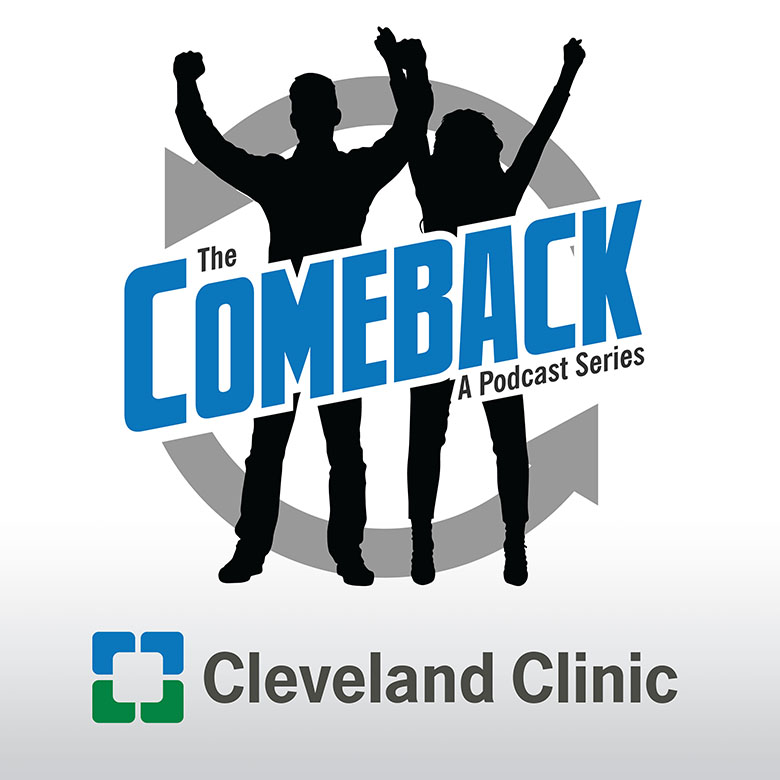Cardiac Risk Assessment for Competitive Athletes

Being involved with a sport comes with a long list of things to do to get ready to play. One item on this list is a pre-participation cardiac screening. Dr. Tamanna Singh, Co-Director of the Sports Cardiology Center, talks about the value of pre-participation screening including a history and physical (H&P) and one common test, an electrocardiogram (EKG).
Learn more about the Sports Cardiology Center at Cleveland Clinic
Read more about cardiac screening for sports
Subscribe: Apple Podcasts | Podcast Addict | Buzzsprout | Spotify
Cardiac Risk Assessment for Competitive Athletes
Podcast Transcript
Announcer:
Welcome to Love Your Heart, brought to you by Cleveland Clinic's Sydell and Arnold Miller Family Heart, Vascular and Thoracic Institute. These podcasts will help you learn more about your heart, thoracic and vascular systems, ways to stay healthy, and information about diseases and treatment options. Enjoy.
Tamanna Singh, MD:
I'm going to go ahead and talk about the incorporation, the history and physical from a cardiac lens and incorporating things like an ECG and other imaging modalities that predominantly echo, coronary CT and MRI moving forward.
So, the goal for this session today is just to discuss what cardiac risk assessment is in athletes, and we typically do hear that language of screening. We really try to steer away from that terminology and really try to push more of a risk assessment vocabulary. We'll talk a little bit about the role of the EKG, in addition to the H and P, as well as what supports that with respect to incorporating that in screening or not. And then we'll dive into some multi-modality imaging in athletes and when that is appropriate.
So, I always like to start by defining what a competitive athlete is, and we use the definition by the Bethesda conferences. So, it's one who participates in an organized team or individual sport that requires regular competition against others as a central component, places a high premium on excellence and achievement and requires some form of systemic, usually intense training. So, it's really a distinctive activity and a lifestyle versus something that you may kind of dabble into or not so much on the day-to-day.
So why do we assess risk in these individuals? And based upon the Inter-Association Consensus Statement on Cardiovascular Care of College Athletes, it's really to identify conditions that may put these individuals at unreasonable risk of death or catastrophic injury, and with the potential to modify and reduce risk through individualized management. This is based upon registry data from about 2003 to 2013, looking at high risk populations for sudden cardiac deaths, specifically among our NCAA athletes. They're predominantly male, African American, and typically basketball players.
And about a quarter percent of screened athletes do have potentially dangerous cardiac conditions that can be identified. And again, just remembering what kind of target cohort are really, we really try to make sure that we're looking at our male gender. Our female athletes, typically from both an electric perspective as well as a cardiomyopathic perspective, are less at risk of sudden cardiac death compared to their male counterparts. But male basketball players definitely, 1 in about 9,000, typically can have that risk of sudden death.
Causes of sudden cardiac death run the gamut. And we typically like to think about the heart as a pump, an electrical circuit, and then we, of course, want to take a look at the coronary vasculature. And so just from a congenital perspective, we always want to make sure we're taking into account familial cardiomyopathies, congenital abnormalities, anything that can be acquired, whether it be atherosclerosis in our masters' athletes, myocarditis. Particularly, that's been a big topic with this pandemic, at least early on, and then some of the electrical derangements. And then we can always have a structurally normal heart and have situations where sudden cardiac death can be precipitated. That can be with toxins, that can be with environmental factors, anything related to temperature acquired long QT, perhaps drug related, and then commotio cordis.
So how does the NCAA support cardiac assessment? So, it supports the concept. We do incorporate the American Heart Association 14-point recommendation, as well as the pre-participation and physical evaluation questioning tools or the PPE-4. And when we think about cardiac assessments, there's really no consensus as to whether or not there is a long-term benefit or is there a risk of using EKGs for cardiac risk assessment.
But if they are used, one of the most important things is that we actually have cardiovascular specialists who are able to interpret those EKGs with the lens of an athlete. And we'll talk a lot about how EKGs that may be abnormal in our sedentary population may not be abnormal in our athlete population.
It's important to make sure that we can implement these screening strategies for all of our athletes and really make sure we're incorporating those high-risk groups. And then it's also important to tell our athletes what we're doing. We want to make sure that they understand what the rationale is behind the ECG tool as a cardiac risk assessment strategy and what the risks and benefits of using that tool if it's not used appropriately can be.
So, when we think about how we begin with our assessment, it's with any athlete, we make sure that we have a very comprehensive history and physical, and we really try to probe these athletes. A lot of them can understand that whatever information they do provide to us is going to determine what we do downstream. And many of them do need the help of their families to understand what their family history is. And that can also be very important to determine if certain symptoms are worthy of further evaluation. So, we're always keeping our ears out for listening for common symptoms like chest discomfort, difficulty breathing, if they're syncopating with exertion, if they're noticing a decline in their performance, any family history of sudden death or premature coronary disease or any sort of familial cardiomyopathy is going to be relevant.
And this will lead to a very focused cardiovascular exam. Oftentimes it may lead to an EKG, but that's also just very dependent on the institution that's doing the risk assessment. Exams are always going to include getting blood pressures, making sure we do a full cardiac exam, femoral pulses, whatnot. And then, of course, looking for any sort of stigmata of connective tissue disease like Marfan's or Ehler-Danlos and whatnot.
ECG interpretation, this is typically what we use as sports cardiologists and we're trying to determine with our ECG tool what is normal, what is abnormal, and what requires additional investigation. There are a couple of things that are normal for athletes that perhaps may not be normal for non-athletes.
So, some things to think about with respect to whether or not we should include an EKG in our discussions with cardiac risk assessment programs, there can be benefits of mass screening. We can identify small numbers of athletes who may have this increased risk of death or perhaps have not had a diagnosed cardiomyopathy or whatnot. But the caveat is there's still limited evidence supporting the effectiveness of this type of screening tool to achieve actual prevention of sports-related death. They still tend to happen. It is currently practiced and mandated in three countries. We do practice it as here in the US, but it is not mandated.
And for the athlete, again, we always have to make sure that we're justifying what we are doing and that they understand why our approach is such with respect to risk assessment, because they've never really had an EKG before they've come to see us. It can be very stress-provoking. And of course, they're always wondering, well, is this going to be something that's going to keep me off the team or off the court or whatnot?
So, let's dive in a little bit to the efficacy of cardiovascular assessments with the EKG versus just the H and P alone. They were able to demonstrate a very sharp decrease in mortality rate over a 30-year period, which the investigators think is related to the EKG. I bring that up just to show that it has been demonstrated to reduce mortality, but again, not without its caveats.
There is some evidence from the US and Israel that diminishes the value of EKG with respect to reducing athlete mortality. And so that kind of predisposes to how ECGs have been incorporated nationwide. And what we're noticing is that the mortality directly attributed to routine EKG is really more of an observation that's primarily driven by low event rates in competitive athletes with cardiovascular disease.
So, what are some cons of just an isolated H and P, since we kind of talked a little bit about the limitations of utilizing an EKG? Well, the questions, as you can see, can be very broad and nonspecific, and if someone's not really using one of these recommended tools, they can be very nonspecific, and we can miss things. It can lead to a lot of false positives or false negatives. And in fact, 24 to 43 percent of college athletes reported at least one positive cardiovascular symptom or family history when the AHA or PPE tools were used, and 68 percent of high school athletes reported a positive history.
So those positive historical findings are going to predicate what we want to do, and that's where an EKG can be very helpful to determine whether or not those symptoms are something that we need to investigate further. So, the addition of a resting EKG for screening protocols hasn't really been shown in an adequately designed study to prevent sudden cardiac death. Unfortunately, an EKG is not helpful when we have other causes of sudden cardiac death that can't be seen on a rhythm strip, such as anomalous coronaries or acropathies.
So just to summarize, pre-participation cardiac screening in athletes is super valuable in identifying a lot of conditions that can be associated with sudden cardiac death. And we already said that including an EKG can really be helpful in improving sensitivity and specificity. Again, going back to whether an athlete can play, it's just super important to understand what the limitations are with all of these tools, making sure you're looking through a sports cardiology lens to ensure that an athlete is getting treated appropriately, fairly, and can get back to what they love doing.
Announcer:
Thank you for listening. We hope you enjoyed the podcast. We welcome your comments and feedback. Please contact us at heart@ccf.org. Like what you heard? Subscribe wherever you get your podcasts or listen at clevelandclinic.org/loveyourheart podcast.

Love Your Heart
A Cleveland Clinic podcast to help you learn more about heart and vascular disease and conditions affecting your chest. We explore prevention, diagnostic tests, medical and surgical treatments, new innovations and more.


